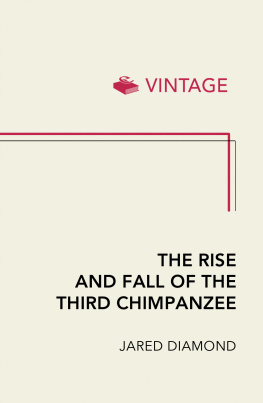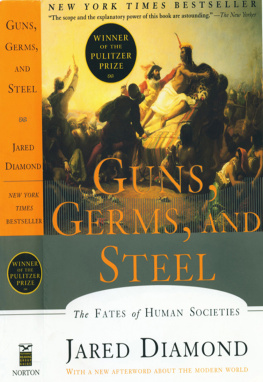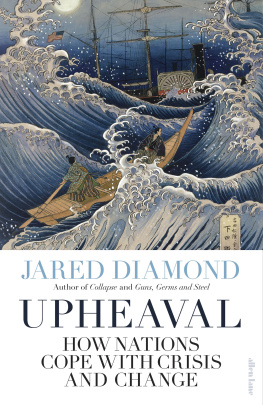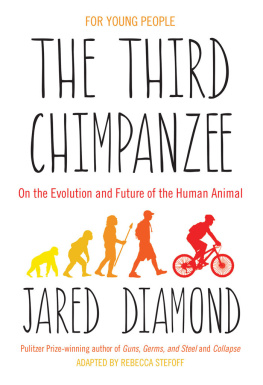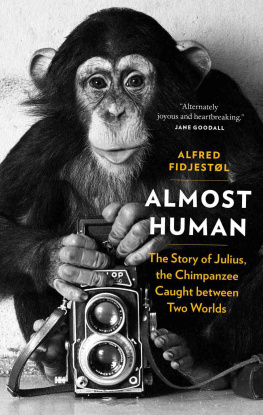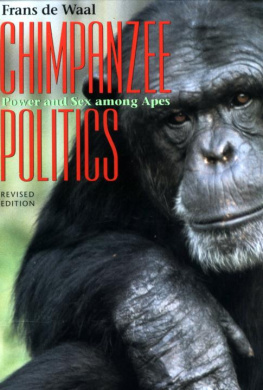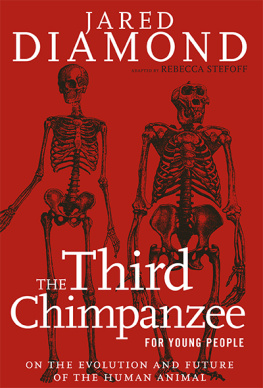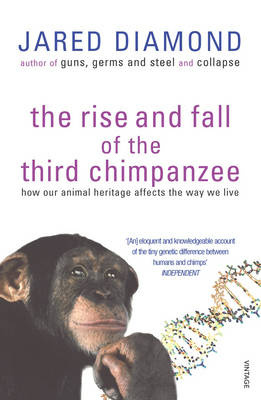Jared Diamond - The Rise and Fall of the Third Chimpanzee
Here you can read online Jared Diamond - The Rise and Fall of the Third Chimpanzee full text of the book (entire story) in english for free. Download pdf and epub, get meaning, cover and reviews about this ebook. year: 0, publisher: Random House, genre: Romance novel. Description of the work, (preface) as well as reviews are available. Best literature library LitArk.com created for fans of good reading and offers a wide selection of genres:
Romance novel
Science fiction
Adventure
Detective
Science
History
Home and family
Prose
Art
Politics
Computer
Non-fiction
Religion
Business
Children
Humor
Choose a favorite category and find really read worthwhile books. Enjoy immersion in the world of imagination, feel the emotions of the characters or learn something new for yourself, make an fascinating discovery.
- Book:The Rise and Fall of the Third Chimpanzee
- Author:
- Publisher:Random House
- Genre:
- Year:0
- Rating:4 / 5
- Favourites:Add to favourites
- Your mark:
- 80
- 1
- 2
- 3
- 4
- 5
The Rise and Fall of the Third Chimpanzee: summary, description and annotation
We offer to read an annotation, description, summary or preface (depends on what the author of the book "The Rise and Fall of the Third Chimpanzee" wrote himself). If you haven't found the necessary information about the book — write in the comments, we will try to find it.
More than 98 percent of human genes are shared with two species of chimpanzee. The third chimpanzee is man. Jared Diamond surveys out life-cycle, culture, sexuality and destructive urges both towards ourselves and the planet to explore the ways in which we are uniquely human yet still influenced by our animal origins.
The Rise and Fall of the Third Chimpanzee — read online for free the complete book (whole text) full work
Below is the text of the book, divided by pages. System saving the place of the last page read, allows you to conveniently read the book "The Rise and Fall of the Third Chimpanzee" online for free, without having to search again every time where you left off. Put a bookmark, and you can go to the page where you finished reading at any time.
Font size:
Interval:
Bookmark:
C ONTENTS
About the Book
More than 98 percent of human genes are shared with two species of chimpanzee. The third chimpanzee is man. Jared Diamond surveys out life-cycle, culture, sexuality and destructive urges both towards ourselves and the planet to explore the ways in which we are uniquely human yet still influenced by our animal origins.
About the Author
Jared Diamond is among Americas most remarkable scholars. While, by appointment, a Professor of Physiology at the University of California Medical School, he is equally celebrated for his brilliant contributions to ecology and evolutionary biology, and for his explorations of remote parts of New Guinea. The Rise and Fall of the Third Chimpanzee won the Rhne-Poulenc Science Book Prize in 1992, as did Guns, Germs and Steel in 1998.
Also by Jared Diamond
Guns, Germs and Steel: A Short History of
Everybody for the Last 13,000 Years
Collapse: How Societies Choose to Fail or Survive
Why is Sex Fun? The Evolution of
Human Sexuality
L IST OF I LLUSTRATION
M APS
. World Conquest
. Axes of the Old and New Worlds
. Language of Europe and Western Asia Map
. A Sheep is a Sheep is a Sheep
. Honourable Root, Dishonourable Word
. How Indo-European Languages Might Have Spread
. Some Genocides, 14921900
. Some Genocides, 19001950
. Some Genocides, 19501990
F IGURES
. Family Tree of the Higher Primates
. The Human Family Tree
. Males, as Females See Them
. Females, as Males See Them
I LLUSTRATION
Ishi, the last surviving Indian of the Yahi tribe
Dedicated to my sons
Max and Joshua,
to help them understand
where we came from
and where we may be heading

T HEME
How the human species changed, within a short time,
from just another species of big mammal
to a world conqueror;
and how we acquired the capacity
to reverse all that progress overnight
P ROLOGUE
It is obvious that humans are unlike all animals. It is also obvious that we are a species of big mammal, down to the minutest details of our anatomy and our molecules. That contradiction is the most fascinating feature of the human species. It is familiar, but we still have difficulty grasping how it came to be and what it means.
On the one hand, between ourselves and all other species lies a seemingly unbridgeable gulf that we acknowledge by defining a category called animals. It implies that we consider centipedes, chimpanzees, and clams to share decisive features with each other but not with us, and to lack features restricted to us. Among these characteristics unique to us are the abilities to talk, write, and build complex machines. We depend completely on tools, not just on our bare hands, to make a living. Most of us wear clothes and enjoy art, and many of us believe in a religion. We are distributed over the whole Earth, command much of its energy and production, and are beginning to expand into the ocean depths and into space. We are also unique in darker attributes, including genocide, delight in torture, addictions to toxic drugs, and extermination of other species by the thousands. While a few animal species have one or two of these attributes in rudimentary form (like tool use), we still far eclipse animals even in those respects.
Thus, for practical and legal purposes, humans are not animals. When Darwin intimated in 1859 that we had evolved from apes, it is no wonder that most people initially regarded his theory as absurd and continued to insist that we had been separately created by God. Many people, including a quarter of all American college graduates, still hold to that belief today.
On the other hand, we obviously are animals, with the usual animal body parts, molecules, and genes. It is even clear what particular type of animal we are. Externally, we are so similar to chimpanzees that eighteenth-century anatomists who believed in divine creation could already recognize our affinities. Just imagine taking some normal people, stripping off their clothes, taking away all their other possessions, depriving them of the power of speech, and reducing them to grunting, without changing their anatomy at all. Put them in a cage in the zoo next to the chimp cages, and let the rest of us clothed and talking people visit the zoo. Those speechless caged people would be seen for what we all really are: a chimp that has little hair and walks upright. A zoologist from outer space would immediately classify us as just a third species of chimpanzee, along with the pygmy chimp of Zaire and the common chimp of the rest of tropical Africa.
Molecular genetic studies over the last half-a-dozen years have shown that we continue to share over ninety-eight per cent of our genes with the other two chimps. The overall genetic distance between us and chimps is even smaller than the distance between such closely related bird species as red-eyed and white-eyed vireos, or willow warblers and chiffchaffs. So we still carry most of our old biological baggage with us. Since Darwins time, fossilized bones of hundreds of creatures variously intermediate between apes and modern humans have been discovered, making it impossible for a reasonable person to deny the overwhelming evidence. What once seemed absurd our evolution from apes actually happened.
Yet the discoveries of many missing links have only made the problem more fascinating, without fully solving it. The few bits of new baggage we acquired the two per cent of our genes that differ from those of chimps must have been responsible for all of our seemingly unique properties. We underwent some small changes with big consequences rather quickly and recently in our evolutionary history. In fact, as recently as a hundred thousand years ago that zoologist from outer space would have viewed us as just one more species of big mammal. Granted, we had a couple of curious behavioural habits, notably our control of fire and our dependence on tools, but those habits would have seemed no more curious to the extraterrestrial visitor than would the habits of beavers and bowerbirds. Somehow, within a few tens of thousands of years a time that is almost infinitely long when measured against one persons memory but is only a tiny fraction of our species separate history we had begun to demonstrate the qualities that make us unique and fragile.
What were those few key ingredients that made us human? Since our unique properties appeared so recently and involved so few changes, those properties or at least their precursors must already be present in animals. What are those animal precursors of art and language, of genocide and drug abuse?
Our unique qualities have been responsible for our present biological success as a species. No other large animal is native to all the continents, or breeds in all habitats from deserts and the Arctic to tropical rainforests. No large wild animal rivals us in numbers. But among our unique qualities are two that now jeopardize our existence: our propensities to kill each other and to destroy our environment. Of course, both propensities occur in other species: lions and many other animals kill their own kind, while elephants and others damage their environment. However, these propensities are much more threatening in us than in other animals because of our technological power and exploding numbers.
There is nothing new about prophecies to the effect that the end of the world is near if we do not repent. What is new is that such a prophecy is now true, for two obvious reasons. First, nuclear weapons give us the means to wipe ourselves out quickly: no humans possessed this means before. Second, we already appropriate about forty per cent of the Earths net productivity (that is, the net energy captured from sunlight). With the worlds human population now doubling every forty-one years, we will soon have reached the biological limit to growth, at which point we will have to start fighting each other in deadly earnest for a slice of the worlds fixed pie of resources. In addition, given the present rate at which we are exterminating species, most of the worlds species will become extinct or endangered within the next century, but we depend on many species for our own life support.
Next pageFont size:
Interval:
Bookmark:
Similar books «The Rise and Fall of the Third Chimpanzee»
Look at similar books to The Rise and Fall of the Third Chimpanzee. We have selected literature similar in name and meaning in the hope of providing readers with more options to find new, interesting, not yet read works.
Discussion, reviews of the book The Rise and Fall of the Third Chimpanzee and just readers' own opinions. Leave your comments, write what you think about the work, its meaning or the main characters. Specify what exactly you liked and what you didn't like, and why you think so.

